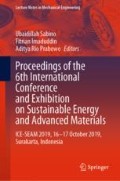Abstract
Solar photovoltaic (PV) system has drawn the tremendous attention of researchers and governments in the past recent years. However, operating temperature of PV has major role to its efficiency and lifetime. This paper reported an experiment of aluminum heat sink as a cooling device to reduce the operating temperature and to improve the performance of PV panels. The performance of PV panels with and without aluminum heat sink were compared. Result showed that solid heat sink increased the average power output by 3.14 W and efficiency by 1.61%. Modification by perforating the fins increased the average output power by 1.79 W and efficiency by 0.60% compared to the solid heat sink. This cooling method was an effective and potential to be applied on commercial PV panels.
Access this chapter
Tax calculation will be finalised at checkout
Purchases are for personal use only
References
Handayani NA (2019) Potency of solar energy applications in Indonesia. Int J Renew Energy Dev 1(2):33
Kibria MT (2014) A review: comparative studies on different generation solar cells technology. In: International conference on environmental aspects of Bangladesh 51–53 (2014)
Parida B (2011) A review of solar photovoltaic technologies. Renew Sustain Energy Rev 15(3):1625–1636
Teo HG (2012) An active cooling system for photovoltaic modules. Appl Energy 90(1):309–315
Jiang J-A (2005) Maximum power tracking for photovoltaic power systems. Tamkang J Sci Eng 8(2):147–153
Rahman MM (2015) Effects of various parameters on PV-module power and efficiency. Energy Convers Manag 103:348–358
Hasanuzzaman M (2016) Global advancement of cooling technologies for PV systems: a review. Sol Energy 137:25–45
Idoko L (2018) Enhancing PV modules efficiency and power output using multi-concept cooling technique. Energy Rep 4:357–369
Radziemska E (2003) Thermal performance of Si and GaAs based solar cells and modules: a review. Prog Energy Combust Sci 29(5):407–424
Gotmare JA (2015) Experimental investigation of PV panel with fin cooling under natural convection. Int J Adv Technol Eng Sci 03:447–454 (2015)
Cengel Y (2014) Heat and mass transfer: fundamentals and applications. McGraw-Hill Higher Education
Doori WHARA (2011) Enhancement of natural convection heat transfer from the rectangular fins by circular perforations. Int J Autom Mech Eng 4:428–436
Mahmod AM (2008) Determination of the temperature distribution the perforated fins under natural convection. Tikrit J Eng Sci 15(2):63–78
Jassem RR (2013) Effect the form of perforation on the heat transfer in the perforated fins. Acad Res Int 4(3)
Modul Surya Terapung Dengan Metode Thermosiphon (2018) Institut Teknologi Bandung
Tobnaghi DM (2013) Investigation of light intensity and temperature dependency of solar cells electric parameters. Electr Power Eng Contol Syst 90–93
Acknowledgements
This work partially supported by the grant of PDUPT from the Ministry of Research, Technology, and Higher Education, the Republic of Indonesia with contract number 719/UN.27.21/PN/2019 for FY 2019.
Author information
Authors and Affiliations
Corresponding author
Editor information
Editors and Affiliations
Rights and permissions
Copyright information
© 2020 Springer Nature Singapore Pte Ltd.
About this paper
Cite this paper
Guardian, I., Sutanto, B., Rachmanto, R.A., Hadi, S., Arifin, Z. (2020). Improving the Performance of Photovoltaic Panels by Using Aluminum Heat Sink. In: Sabino, U., Imaduddin, F., Prabowo, A. (eds) Proceedings of the 6th International Conference and Exhibition on Sustainable Energy and Advanced Materials. Lecture Notes in Mechanical Engineering. Springer, Singapore. https://doi.org/10.1007/978-981-15-4481-1_42
Download citation
DOI: https://doi.org/10.1007/978-981-15-4481-1_42
Published:
Publisher Name: Springer, Singapore
Print ISBN: 978-981-15-4480-4
Online ISBN: 978-981-15-4481-1
eBook Packages: EngineeringEngineering (R0)

